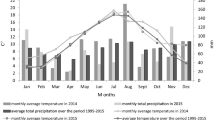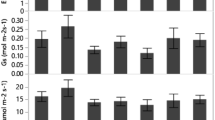Abstract
Drought survival in perennial forage plants involves different adaptative responses such as delay of dehydration through water uptake, limitation of water loss and tolerance of tissues to dessication. To compare the importance of these responses in contrasting cultivars of forage grasses at the whole plant level, we carried out two experiments under glasshouse conditions. Plants of cocksfoot (Dactylis glomerata L.) cultivars, cvs. Currie, Medly (both of Mediterranean origin) and Lutetia (of continental origin), and of tall fescue (Festuca arundinacea L.) cv. Centurion (Mediterranean) were grown in 60 cm-deep cylinders to eliminate the effect of differences of root depth on water availability whilst allowing severe drought to be imposed at a realistic rate. In both experiments, the cvs. were ranked similarly for plant survival, with high mortality for Centurion, low for the Mediterranean cocksfoots Currie and Medly, and intermediate for Lutetia. These differences could not be ascribed to water use during most of the drought period since water uptake and decrease in leaf extension were not significantly different between species and cultivars. However, resistant cvs. of cocksfoot were able to extract water for a longer period and at a lower soil water potential (Ψs) than other cvs. The critical Ψs at plant death was −3.8 and −3.6 MPa for Medly and Currie and −3.0-,−2.6 MPa for Lutetia and Centurion. Moreover, at a low soil water reserve (15–2%), membrane stability and water content were maintained for longer in enclosed immature leaf bases of cocksfoots cultivars, whereas the fescue Centurion exhibited accelerated lamina senescence and steady increase of membrane damage in surviving tissues. Therefore, it is proposed that the drought resistance of tall fescue in the field can mainly be ascribed to its ability to develop a deep root system. In cocksfoot, dehydration tolerance in surviving tissues and the ability of roots to extract water at low soil water potentials may, in addition to root depth, contribute significantly to plant survival under severe drought.
Similar content being viewed by others
References
Blum A 1996 Crop responses to drought and the interpretation of adaptation. Plant Growth Regul. 20, 135–148.
Blum A and Ebercon A 1981 Cell membrane stability as a measure of drought and heat tolerance in wheat. Crop Sci. 21, 43–47.
Bonos S A and Murphy J A 1999 Growth responses and performance of kentucky bluegrass under summer stress. Crop Sci. 39, 770–774.
Boyer J S 1982 Plant productivity and environment.Science 218, 443–448.
Bray E A 1993 Molecular responses to water deficit. Plant Physiol. 103, 11–16.
Carrow R N 199a Drought resistance aspects of turfgrasses in the Southeast: Root-shoot responses. Crop Sci. 36, 687–694.
Carrow R N 1996b Drought avoidance characteristics of diverse tall fescue cultivars. Crop Sci. 36, 371–377.
Crowe J H, Crowe L M, Carpenter J F and Aurell Wistrom C 1987 Stabilization of dry phospholipid bilayers and proteins by sugars. Biochem. J. 242, 1–10.
Ervin E H and Koski A J 1998 Drought avoidance aspects and crop coefficients of kentucky bluegrass and tall fescue turfs in the semiarid west. Crop Sci. 38, 788–795.
Hanson A D and Hitz W D 1982 Metabolic responses of mesophytes to plant water deficit. Annu. Rev. Plant Physiol. 33, 163–203.
Hsiao T C 1973 Plant responses to water stress. Ann Rev. Plant Physiol. 24, 519–70.
Howarth C J, Pollock C J and Peacock J M 1997 Development of laboratory-based methods for assessing seedling thermotolerance in pearl millet. New Phytol. 137, 129–139.
Johnson D A and Assay K H 1993 Viewpoint:Selection for improved drought response in cool-season grasses. J. Range Manage. 46, 194–202.
Jones M M, Turner N C and Osmond C B 1981 Mechanisms of drought resistance. In Physiology and Biochemistry of Drought Resistance in Plants. Eds LG Paleg and D Aspinall. pp 15–37. Academic Press, New York.
Kramer P J and Boyer J S 1995 Water relations of plants and soils. Academic Press, London. 495 p.
Lelièvre F and Desplobins G 1994 Pure lucerne or lucerne in association with grasses for extensive pastures in dry Northern Mediterranean areas. In Management and Breeding of Perennial Lucerne for Diversified purposes. Ed. Proceedings FAO-Eucarpia Meeting. pp 89–92. FAO, Rome.
Leopold A C, Musgrave M E and Williams K M 1981 Solute leakage resulting from leaf dessication. Plant Physiol. 68, 1222–1225.
Levitt J 1980 Responses of plants to environmental stresses, Vol. 2. Academic Press, New York.
Ludlow M M 1989 Strategies of response to water stress. In Structural and Functional Responses to Environmental Stresses. Eds. KH Kreeb, H Richter and TM Hinckley. pp 269–281. SPB Academic Publishing bv, The Hague.
Ludlow M M and Muchow R C 1990 A critical evaluation of traits for improving crop yields in water-limited environments. Adv. Agron. 43, 107–153.
May L H and Milthorpe F L 1962 Drought resistance of crop plants. Field Crop Abstracts 15, 171–179.
McWilliam J R and Kramer P J 1968 The nature of the perennial response in Mediterranean grasses. I. Water relations and summer survival in Phalaris. Aust. J. Agric. Res. 19, 381–395.
Ofir M 1986 Seasonal changes in the response to temperature of summer-dormant Poa bulbosa L. bulbs. Ann. Bot. 58, 81–89.
Passioura J B 1996 Drought and drought tolerance. Plant Growth Regul. 20, 79–83.
Premachandra G S, Saneoka H and Ogata S 1992 Leaf water relations, osmotic adjustment, cell membrane stability, epicuticular wax load and growth as affected by increasing water deficits in Sorghum. J. Exp. Bot. 42, 739–745.
Qian Y L, Fry J D and Upham W S 1997 Rooting and drought avoidance of warm-season turfgrasses and tall fescue in Kansas. Crop Sci. 37, 905–910.
Reed K F M 1996 Improving the adaptation of perennial ryegrass, tall fescue, phalaris and cocksfoot for Australia. J. Agric. Res. 39, 457–464.
Riga P and Vartanian N 1999 Sequential expression of adaptative mechanisms is responsible for drought resistance in tobacco. Aust. J. Plant Physiol. 26, 211–220.
Torbert H A, Edwards J H and Pedersen J F 1990 Fescues with large roots are drought tolerant. Appl. Agric. Res. 5,3, 181–187.
Turner N C 1997 Further progress in crop water relations. Adv. Agron. 58, 293–338.
Turner N C and Begg J E 1981 Plant-water relations and adaptation to stress. Plant Soil 58, 97–131.
Villiers T A 1975 Dormancy and the survival of plants. The Institute of Biology's Studies in Biology no. 57. London.
Volaire F 1995 Growth, carbohydrate reserves and drought survival strategies of contrasting Dactylis glomerata populations in a Mediterranean environment. J. Appl. Ecol. 32, 56–66.
Volaire F and Thomas H 1995 Effects of drought on water relations, mineral uptake, water-soluble carbohydrate accumulation and survival of two contrasting populations of cocksfoot. Ann. Bot. 75, 513–524.
Volaire F and Lelièvre F 1997 Production, persistence and watersoluble carbohydrate accumulation in 21 contrasting populations of Dactylis glomerata L. subjected to severe drought in the south of France. Aust. J. Agric. Res. 48, 933–944.
Volaire F, Thomas H and Lelièvre F 1998a Survival and recovery of perennial forage grasses under prolonged Mediterranean drought. I. Growth, death, water relations and solute content in herbage and stubble. New. Phytol. 140, 439–449.
Volaire F, Thomas H, Bertagne N, Bourgeois E, Gautier M F and Lelièvre F 1998b Survival and recovery of perennial forage grasses under prolonged Mediterranean drought. II. Water status, solute accumulations, abscisic acid concentration and accumulation of dehydrin transcripts in bases of immature leaves. New Phytol. 140, 451–460.
Author information
Authors and Affiliations
Rights and permissions
About this article
Cite this article
Volaire, F., Lelièvre, F. Drought survival in Dactylis glomerata and Festuca arundinacea under similar rooting conditions in tubes. Plant and Soil 229, 225–234 (2001). https://doi.org/10.1023/A:1004835116453
Issue Date:
DOI: https://doi.org/10.1023/A:1004835116453




